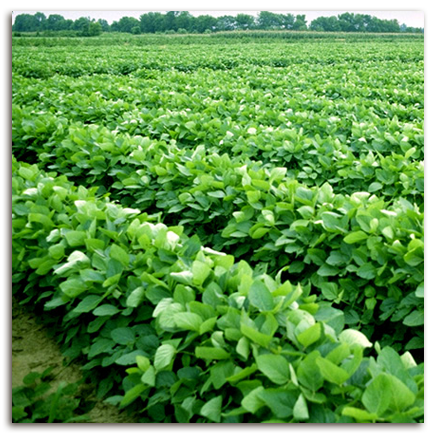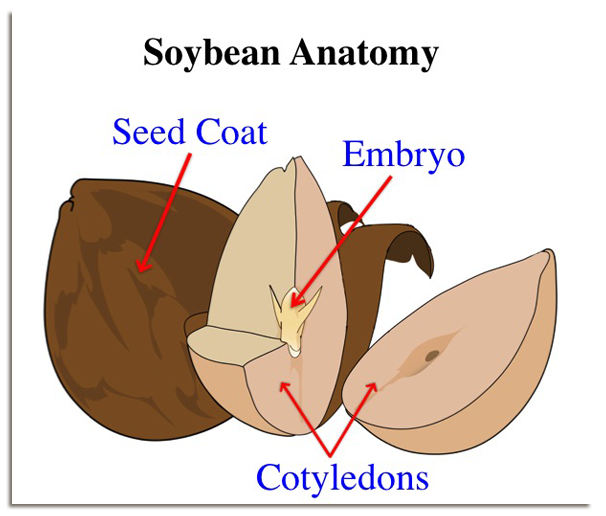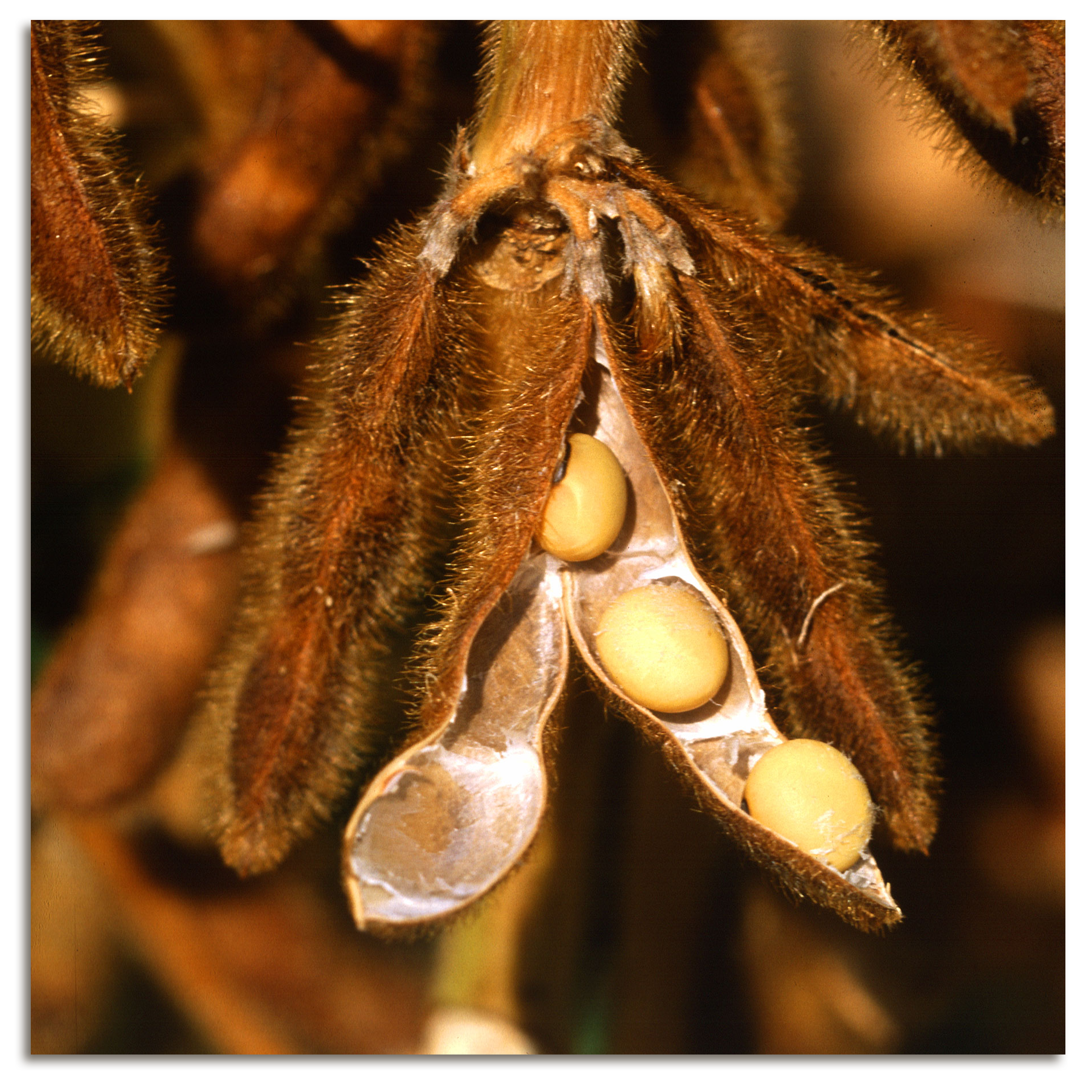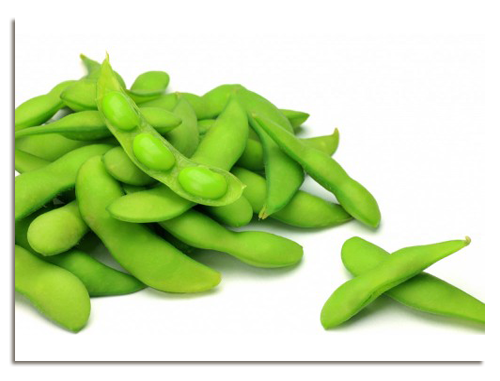 Relevancy and Engagement
agclassroom.org/
Relevancy and Engagement
agclassroom.org/
Bean Seed Cycle
Grade Level
K - 2
Purpose
Students explore how soybeans are grown by farmers, examine seed anatomy through a seed dissection activity, and observe the germination of a soybean plant. Grades K-2
Estimated Time
60 minutes
Materials Needed
Engage:
- Soybean Pictures
- Edamame samples
Activity 1: Seed Dissection
- Soybean plant or Soybean Commodity Card
- Soybean seeds (soaked overnight), 1 per student (soybean seeds can be obtained from local farmers or regular bean seeds from a garden center can be used)
- Soybean products (chocolate, plastic, crayons, and vegetable oil)
Activity 2: Bean Book
- Bean Book handout, 1 per student
- Scissors
- Glue
- Stapler
- Permanent marker
Activity 3: Bean Seed Planting
- Soybean seeds (not soaked in water), 3 per student
- Paper cups with drain holes punched in the bottom
- Soil
- Optional — soybean plant
Vocabulary
cotyledon: an embryonic leaf in seed-bearing plants, one or more of which are the first leaves to appear from a germinating seed
edamame: immature green soybeans boiled or steamed in their pods and harvested before the ripening stage
embryo: a human, animal, or plant in the early stages of development before it is born, hatched, sprouted, etc.
legume: a type of plant which has seeds contained in a pod such as a soybean, pea, or alfalfa plant
seed coat: the protective outer covering of a seed
soybean: a cultivated plant of the pea family which produces edible seeds used in a variety of foods and animal feeds
Did You Know?
- Each soybean pod produces three to four beans; occasionally they will produce five beans, but this is very rare.
- The soybean was first introduced to America in 1765 by a sailor named Samuel Bowen.
- One acre of soybeans (about the size of a football field) can produce 2,500 gallons of soymilk, 40,000 8-ounce (226 g) servings of tofu, and over 82,000 crayons.
- The top producing states of soybeans in the United States include Iowa, Illinois, Minnesota, Nebraska, and Indiana.
- The elevators in the Statue of Liberty use a soybean-based hydraulic fluid.
Background Agricultural Connections
Soybeans are bushy green plants from the legume family. Scientifically speaking, legume plants have the ability to use soil bacteria to form a nodule on their roots by pulling nitrogen from the air and using this nutrient for growth. A simpler description of a legume is a plant that produces a seed that is contained in a pod. Examples of legumes grown in agriculture include soybeans, peas, and alfalfa. Legume crops are a natural benefit to soil quality on farms. The ability of legumes to “fix" their own nitrogen reduces the cost to farmers and gardeners for fertilizers and can be used in a crop rotation to replenish nitrogen in the soil. The fixating of nitrogen by soybeans also causes the seeds and pods to have very high protein contents.
 Soybeans are planted on farms in the spring after the last frost. After the seed germinates and begins to grow, it matures into a bushy, green plant which blooms in late summer. From these white or purple blossoms a pod begins to form. During the fall season, the soybeans mature, and the plant begins to turn yellow. The soybeans are harvested using a machine called a combine. The combine cuts the entire soybean plant and separates the soybeans from their pods and stems. The soybeans are then collected and trucked to facilities where they are stored and processed.
Soybeans are planted on farms in the spring after the last frost. After the seed germinates and begins to grow, it matures into a bushy, green plant which blooms in late summer. From these white or purple blossoms a pod begins to form. During the fall season, the soybeans mature, and the plant begins to turn yellow. The soybeans are harvested using a machine called a combine. The combine cuts the entire soybean plant and separates the soybeans from their pods and stems. The soybeans are then collected and trucked to facilities where they are stored and processed.
 All members of the bean family (soybeans, lima beans, kidney beans, green beans, etc.) have the same seed anatomy. A seed coat is a very thin layer on the outer most surface of the seed. The seed coat offers protection to the cotyledons and the embryo. The cotyledons, or seed leaves, are the first leaves visible on a bean plant. These seed leaves are thick and contain stored glucose (food) for the new plant to grow. Before the seed is planted, the cotyledons are usually not green. When the plant sprouts, or germinates, chlorophyll is activated, and the cotyledons become green. The very center of a seed contains the embryo. This embryo is the new, or “baby,” plant that will sprout out of the soil. If bean seeds are soaked in water for a few hours, they can easily be pulled apart, and these major bean seed parts will be visible.
All members of the bean family (soybeans, lima beans, kidney beans, green beans, etc.) have the same seed anatomy. A seed coat is a very thin layer on the outer most surface of the seed. The seed coat offers protection to the cotyledons and the embryo. The cotyledons, or seed leaves, are the first leaves visible on a bean plant. These seed leaves are thick and contain stored glucose (food) for the new plant to grow. Before the seed is planted, the cotyledons are usually not green. When the plant sprouts, or germinates, chlorophyll is activated, and the cotyledons become green. The very center of a seed contains the embryo. This embryo is the new, or “baby,” plant that will sprout out of the soil. If bean seeds are soaked in water for a few hours, they can easily be pulled apart, and these major bean seed parts will be visible.

Soybeans are one of the most versatile crops in the world. When crushed and pressed, soybeans produce oil used in margarine, cooking oils, salad dressings, mayonnaise, and many prepared foods. Soybean oil contains no cholesterol and is low in saturated fat, so it is popular with health-conscious people. Soybean oil is also used to make paints, varnishes, soaps, cosmetics, plastics and crayons. Soybean oil is even used to make ink for printing newspapers and magazines. Soy biodiesel is another product made from soybean oil. This fuel is used in cars, trucks, and buses which reduces pollution and increases engine performance. After soybean oil is removed in processing, the remaining flakes are processed into food products or protein meal for animals. Soybean meal is an important protein source for livestock and poultry.
 Edamame is an immature soybean harvested before it becomes dry and hardened. This variety of soybean is grown primarily for eating. These bright green soybeans can be purchased at the grocery store shelled or in the pod, fresh or frozen. The variety of soybean used for edamame typically has two or three beans per pod. In contrast, soybeans grown commercially for animal feed, oil, and other byproducts have three beans per pod.
Edamame is an immature soybean harvested before it becomes dry and hardened. This variety of soybean is grown primarily for eating. These bright green soybeans can be purchased at the grocery store shelled or in the pod, fresh or frozen. The variety of soybean used for edamame typically has two or three beans per pod. In contrast, soybeans grown commercially for animal feed, oil, and other byproducts have three beans per pod.
Engage
- Using the Soybean Pictures, show students the edamame and the mature soybean pod.
- Allow the students time to look at the pictures, and ask them to tell you what these two items have in common. Then, ask what is different.
- Ask the students if they know what the pictures represent. (soybeans)
- Ask the students the following questions:
- "Do you know where soybeans are grown?" (soybean fields mainly in the Midwestern region of the United States)
- "Who grows soybeans?" (farmers)
- "Have you ever eaten a soybean?" (edamame, tofu, soymilk, soy sauce)
- "Are soybeans (edamame) healthy for you to eat?" (Yes, they are high in protein, iron, and calcium and low in calories.)
- "What are some uses of soybeans?" (cooking oils, mayonnaise, margarines, salad dressings, cosmetics, lubricants, and biodiesel)
- "Would you like to try eating some soybeans (edamame)?"
- After checking for any applicable food allergies, allow your students to taste the edamame. Tell the students they will be learning more about soybeans and how they grow.
Explore and Explain
Activity 1: Seed Dissection
- One day before class, soak enough soybean (or any other kind of bean) seeds in water so each student can have one seed.
- Display a soybean for the class to see.
- Note: Soybean plants can be obtained from area farmers, you can grow your own from a soybean seed, or a picture of a soybean plant would also work. If an actual plant is not available, use the Soybean Commodity Card.
- Tell students that soybeans are an important crop. They are commonly grown in many Midwestern states. If possible, bring in products that contain soybeans (chocolate, plastic, crayons, vegetable oil, etc.), and explain to the students that all of these products are made using part of the soybean seed.
- Use the information in the Background Agricultural Connections to give a brief explanation of how soybeans are grown.
- Give each student a water-soaked soybean seed. Explain to the students that there are three major parts to a seed: the seed coat, seed leaves (cotyledons), and an embryo.
- Assist your students in dissecting the bean seed:
- Peel off the seed coat – it is a very thin, almost transparent, film on the outer surface of the seed.
- Gently split the seed in half, separating the cotyledons or seed leaves. Explain to the students that these cotyledons provide food for the plant as it is sprouting.
- In the center of the cotyledons should be a small embryo. Explain to the students that this embryo is what will sprout and grow into a plant.
Activity 2: Bean Book
- Before class begins, make enough copies of the Bean Book so each student has an instruction sheet, seed coat sheet, seed leaves (cotyledon sheet) and one embryo. (There are six embryos per page.) If possible use colored copies to help students visualize the seed parts or allow students to color their Bean Book. Example: Brown for seed coat sheet, yellow for seed leaves (cotyledon) sheet, and green for the embryo sheet.
- After students have dissected their bean seed have them throw away all seed parts. Then distribute the Bean Book handouts. Read the directions and model to the students what they should do to assemble the book. Assist students in creating their own Bean Book.
- After the Bean Books are assembled, show students how to use them to read about the seed and illustrate the parts.

Activity 3: Bean Seed Planting
- Give each student about 3 bean seeds (not soaked in water). Ask the students what is needed to help these seeds grow. (mositure, air, and the proper temperature)
- Pass out planting containers (paper or plastic cups with drain holes punched in the bottom work well). Assist students in writing their name on the cups with a permanent marker.
- Have buckets or containers with soil available. Model the following instructions for the students:
- Fill a cup about 1/2-3/4 full of soil. Have students follow your example to fill their containers.
- Poke three holes, using a pencil or your finger, about one inch deep into the soil.
- Drop one seed into each hole. Cover the seeds loosely with soil.
- Use a spray bottle to moisten the soil in the container or pour water on the soil until water flows out the holes in the bottom of the container. Be sure to water over a sink or container.
- Assist the students with planting the seeds.
- Place the containers in a sunny window and water when the soil is dry to the touch.
- Discuss with students what they think will happen to the seeds. (sprout, grow into plants, and produce more seeds).
- In five to ten days, a sprout will emerge in each container. If more than one seed sprouts or germinates, have students carefully pull out all but the healthiest plant.
Elaborate
-
Instruct students to take daily, weekly, etc. observations of their growing bean plant. They can also take measurements and diagram the growth of these plants. Make a calendar to give to each student to keep records of their plants’ growth.
-
Invite a local soybean farmer to visit your classroom and share his/her story about raising this important crop.
-
Collect labels from the students’ favorite foods. Look at the ingredients list and see if any of them contain soy or beans.
-
The book Soybeans in the Story of Agriculture by Susan Anderson and JoAnne Buggey is a great read-aloud book or it can be used by the teacher for additional background information.
-
Share the video, Agriculture: How MN Farmers Feed Us, Widboom Soybean Farm which will introduce students to a soybean farm in Minnesota.
-
Use the hands-on activities in the Nuts About Peanuts! lesson plan to further explore the parts of living things and other life science concepts.
Evaluate
After conducting these activities, review and summarize the following key points:
- Soybeans are grown to feed animals and make other food products such as tofu, soy milk, and more.
- Farmers plant soybeans in the spring and harvest them in the fall.
- Livestock animals such as cattle, pigs, sheep, and poultry eat soybean meal which is high in protein. In return, these animals provide milk, meat, and eggs for humans to eat.
Acknowledgements
- My Bean Book created by the Illinois Agriculture in the Classroom program.
- Ag Facts gathered from: https://www.americasfarmers.com
Recommended Companion Resources
Author
Sue Knott
Organization
Minnesota Agriculture in the Classroom